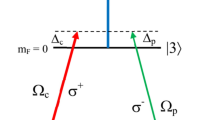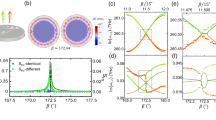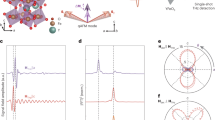Abstract
Magneto-optical (MO) effects have a pivotal role in modern photonic devices for light manipulation and sensing, but the study of these effects has so far been limited to the MO Faraday and Kerr effects. Conventional MO systems encounter considerable intrinsic losses, markedly hampering their ability to amplify the MO effects. Here we introduce a loss-enhanced MO effect to sublinearly amplify the frequency response of a non-Hermitian optical cavity under different background magnetic fields. This exceptional MO effect relies on an architecture of MO material embedded in a Fabry–Pérot cavity, accompanied by a polarization-dependent optical absorption, that is, linear dichroism, to construct a reconfigurable exceptional point. The experimental results show that two eigenmodes of the Fabry–Pérot cavity exhibit sublinear frequency splitting. By electrically reconfiguring the absorber, the eigenfrequency shift can be adaptively enhanced under different background magnetic fields. Using this effect, we demonstrate the detection of subtle magnetic field variations in a strong background, with the system’s response magnified by a factor exceeding 10 and sensitivity increased threefold compared with its conventional Hermitian counterpart. Our study leverages exceptional physics to study the MO effect and develops a new class of reconfigurable MO devices equipped with enhanced sensitivity for potential integration with photonic systems.
This is a preview of subscription content, access via your institution
Access options
Access Nature and 54 other Nature Portfolio journals
Get Nature+, our best-value online-access subscription
$32.99 / 30 days
cancel any time
Subscribe to this journal
Receive 12 print issues and online access
$259.00 per year
only $21.58 per issue
Buy this article
- Purchase on SpringerLink
- Instant access to full article PDF
Prices may be subject to local taxes which are calculated during checkout




Similar content being viewed by others
Data availability
The data that support the plots within this paper are available via figshare at https://doi.org/10.6084/m9.figshare.25998517(ref. 60). All other data used in this study are available from the corresponding authors upon reasonable request.
References
Kimel, A. et al. The 2022 magneto-optics roadmap. J. Phys. D 55, 463003 (2022).
Luo, J. et al. Large effective magnetic fields from chiral phonons in rare-earth halides. Science 382, 698–702 (2023).
Yavorsky, M. A. et al. Topological Faraday effect for optical vortices in magnetic films. Phys. Rev. Lett. 130, 166901 (2023).
Lyalin, I., Alikhah, S., Berritta, M., Oppeneer, P. M. & Kawakami, R. K. Magneto-optical detection of the orbital Hall effect in chromium. Phys. Rev. Lett. 131, 156702 (2023).
Dirnberger, F. et al. Magneto-optics in a van der Waals magnet tuned by self-hybridized polaritons. Nature 620, 533–537 (2023).
Burch, K. S., Mandrus, D. & Park, J.-G. Magnetism in two-dimensional van der Waals materials. Nature 563, 47–52 (2018).
Choi, Y.-G. et al. Observation of the orbital hall effect in a light metal Ti. Nature 619, 52–56 (2023).
Zvezdin, A. K. & Kotov, V. A. Modern Magnetooptics and Magnetooptical Materials (Taylor & Francis, 1997)
Yan, W. et al. Waveguide-integrated high-performance magneto-optical isolators and circulators on silicon nitride platforms. Optica 7, 1555–1562 (2020).
Crassee, I. et al. Giant Faraday rotation in single- and multilayer graphene. Nat. Phys. 7, 48–51 (2011).
Chin, J. Y. et al. Nonreciprocal plasmonics enables giant enhancement of thin-film Faraday rotation. Nat. Commun. 4, 1599 (2013).
Ignatyeva, D. O. et al. All-dielectric magnetic metasurface for advanced light control in dual polarizations combined with high-Q resonances. Nat. Commun. 11, 5487 (2020).
Rizal, C., Shimizu, H. & Mejía-Salazar, J. R. Magneto-optics effects: new trends and future prospects for technological developments. Magnetochemistry 8, 94 (2022).
Rüter, C. E. et al. Observation of parity–time symmetry in optics. Nat. Phys. 6, 192–195 (2010).
Peng, B. et al. Parity–time-symmetric whispering-gallery microcavities. Nat. Phys. 10, 394–398 (2014).
Chang, L. et al. Parity–time symmetry and variable optical isolation in active-passive-coupled microresonators. Nat. Photon. 8, 524–529 (2014).
Xu, H., Mason, D., Jiang, L. & Harris, J. G. E. Topological energy transfer in an optomechanical system with exceptional points. Nature 537, 80–83 (2016).
Chen, H.-Z. et al. Revealing the missing dimension at an exceptional point. Nat. Phys. 16, 571–578 (2020).
Peng, P. et al. Anti-parity–time symmetry with flying atoms. Nat. Phys. 12, 1139–1145 (2016).
Li, Y. et al. Anti-parity–time symmetry in diffusive systems. Science 364, 170–173 (2019).
Wu, Y. et al. Observation of parity–time symmetry breaking in a single-spin system. Science 364, 878–880 (2019).
Xiao, L. et al. Non-Hermitian bulk-boundary correspondence in quantum dynamics. Nat. Phys. 16, 761–766 (2020).
Wang, Y.-T. et al. Experimental investigation of state distinguishability in parity–time symmetric quantum dynamics. Phys. Rev. Lett. 124, 230402 (2020).
El-Ganainy, R. et al. Non-Hermitian physics and PT symmetry. Nat. Phys. 14, 11–19 (2018).
Wang, X.-G., Guo, G.-H. & Berakdar, J. Steering magnonic dynamics and permeability at exceptional points in a parity–time symmetric waveguide. Nat. Commun. 11, 5663 (2020).
Yang, Y. et al. Unconventional singularity in anti-parity–time symmetric cavity magnonics. Phys. Rev. Lett. 125, 147202 (2020).
Zhang, D., Luo, X.-Q., Wang, Y.-P., Li, T.-F. & You, J. Q. Observation of the exceptional point in cavity magnon-polaritons. Nat. Commun. 8, 1368 (2017).
Liu, H. et al. Observation of exceptional points in magnonic parity–time symmetry devices. Sci. Adv. 5, 9144 (2019).
Liang, C., Tang, Y., Xu, A.-N. & Liu, Y.-C. Observation of exceptional points in thermal atomic ensembles. Phys. Rev. Lett. 130, 263601 (2023).
Miri, M.-A. & Alù, A. Exceptional points in optics and photonics. Science 363, 7709 (2019).
Chen, W., Özdemir, Ş. K., Zhao, G., Wiersig, J. & Yang, L. Exceptional points enhance sensing in an optical microcavity. Nature 548, 192–196 (2017).
Hodaei, H. et al. Enhanced sensitivity at higher-order exceptional points. Nature 548, 187–191 (2017).
Hokmabadi, M. P., Schumer, A., Christodoulides, D. N. & Khajavikhan, M. Non-Hermitian ring laser gyroscopes with enhanced Sagnac sensitivity. Nature 576, 70–74 (2019).
Lai, Y.-H., Lu, Y.-K., Suh, M.-G., Yuan, Z. & Vahala, K. Observation of the exceptional-point-enhanced Sagnac effect. Nature 576, 65–69 (2019).
Zhang, X., Hu, J. & Zhao, N. Stable atomic magnetometer in parity–time symmetry broken phase. Phys. Rev. Lett. 130, 023201 (2023).
Wiersig, J. Enhancing the sensitivity of frequency and energy splitting detection by using exceptional points: Application to microcavity sensors for single-particle detection. Phys. Rev. Lett. 112, 203901 (2014).
Peng, B. et al. Loss-induced suppression and revival of lasing. Science 346, 328–332 (2014).
Wong, Z. J. et al. Lasing and anti-lasing in a single cavity. Nat. Photon. 10, 796–801 (2016).
Huang, X., Lu, C., Liang, C., Tao, H. & Liu, Y.-C. Loss-induced nonreciprocity. Light Sci. Appl. 10, 30 (2021).
Dong, S. et al. Loss-assisted metasurface at an exceptional point. ACS Photon. 7, 3321–3327 (2020).
Feng, L. et al. Experimental demonstration of a unidirectional reflectionless parity–time metamaterial at optical frequencies. Nat. Mater. 12, 108–113 (2013).
Li, Z. et al. Synergetic positivity of loss and noise in nonlinear non-hermitian resonators. Sci. Adv. 9, 0562 (2023).
Park, J.-H. et al. Symmetry-breaking-induced plasmonic exceptional points and nanoscale sensing. Nat. Phys. 16, 462–468 (2020).
Wang, H., Lai, Y.-H., Yuan, Z., Suh, M.-G. & Vahala, K. Petermann-factor sensitivity limit near an exceptional point in a Brillouin ring laser gyroscope. Nat. Commun. 11, 1610 (2020).
Lau, H.-K. & Clerk, A. A. Fundamental limits and non-reciprocal approaches in non-Hermitian quantum sensing. Nat. Commun. 9, 4320 (2018).
Kononchuk, R., Cai, J., Ellis, F., Thevamaran, R. & Kottos, T. Exceptional-point-based accelerometers with enhanced signal-to-noise ratio. Nature 607, 697–702 (2022).
Ding, W., Wang, X. & Chen, S. Fundamental sensitivity limits for Non-Hermitian quantum sensors. Phys. Rev. Lett. 131, 160801 (2023).
Zhang, M. et al. Quantum noise theory of exceptional point amplifying sensors. Phys. Rev. Lett. 123, 180501 (2019).
Jacob, D., Vallet, M., Bretenaker, F., Le Floch, A. & Le Naour, R. Small Faraday rotation measurement with a Fabry–Pérot cavity. Appl. Phys. Lett. 66, 3546–3548 (1995).
Zak, J., Moog, E. R., Liu, C. & Bader, S. D. Magneto-optics of multilayers with arbitrary magnetization directions. Phys. Rev. B 43, 6423–6429 (1991).
Özdemir, Ş. K., Rotter, S., Nori, F. & Yang, L. Parity–time symmetry and exceptional points in photonics. Nat. Mater. 18, 783–798 (2019).
Wiersig, J. Response strengths of open systems at exceptional points. Phys. Rev. Res. 4, 023121 (2022).
Wiersig, J. Distance between exceptional points and diabolic points and its implication for the response strength of non-hermitian systems. Phys. Rev. Res. 4, 033179 (2022).
Degen, C. L., Reinhard, F. & Cappellaro, P. Quantum sensing. Rev. Mod. Phys. 89, 035002 (2017).
Hashemi, A., Busch, K., Christodoulides, D. N., Özdemir, Ş. K. & El-Ganainy, R. Linear response theory of open systems with exceptional points. Nat. Commun. 13, 3281 (2022).
Takata, K. et al. Observing exceptional point degeneracy of radiation with electrically pumped photonic crystal coupled-nanocavity lasers. Optica 8, 184–192 (2021).
Liang, J. et al. Polariton spin hall effect in a Rashba–Dresselhaus regime at room temperature. Nat. Photon. 18, 357–362 (2024).
Opechowski, W. Magneto-optical effects and paramagnetic resonance. Rev. Mod. Phys. 25, 264–268 (1953).
Víllora, E. G. et al. Faraday rotator properties of Tb3(Sc1.95Lu0.05)Al3O12, a highly transparent terbium-garnet for visible-infrared optical isolators. Appl. Phys. Lett. 99, 011111 (2011).
Ruan, Y.-P. et al. Observation of loss-enhanced magneto-optical effect. figshare https://doi.org/10.6084/m9.figshare.25998517 (2024).
Acknowledgements
This work was supported by the National Natural Science Foundation of China (grant nos. 92365107, 12334012, 12234012, 12305020, 11935006 and 12421005), the National Key R&D Program of China (grant nos. 2019YFA0308700, 2019YFA0308704, 2022YFA1405000, 2021YFA1400900, 2021YFA0718300 and 2024YFE0102400), the Innovation Program for Quantum Science and Technology (grant nos. 2021ZD0301400 and 2021ZD0301500), the Program for Innovative Talents and Teams in Jiangsu (grant no. JSSCTD202138), the Natural Science Foundation of Jiangsu Province, Major Project (grant no. BK20212004), the Hunan Major Sci-Tech Program (grant no. 2023ZJ1010), the China Postdoctoral Science Foundation (grant no. 2023M731613) and Jiangsu Funding Program for Excellent Postdoctoral Talent (grant no. 2023ZB708). C.-W.Q. acknowledges the support from National Research Foundation (grant no. NRF2021-QEP2-03-P09 with WBS number A-8000708-00-00 and grant no. NRF-CRP26-2021-0004).
Author information
Authors and Affiliations
Contributions
K.X. conceived the original idea and the research, and supervised the project. W.L., H.J., Y.-Q.L. and C.-W.Q. contributed to the idea and co-supervised the project. Y.-P.R. conducted the experiment and performed the data analysis and processing. J.-S.T., Z.L., Y.-P.R., W.L., H.J., C.-W.Q. and K.X. contributed to the theoretical model and interpretation of experimental results. K.X. presented the electric constitutive relation and solely derived the interaction Hamiltonian. H.W., W.Z. and H.Z. contributed to the experimental implementation and details. S.-J.G. and W.H. fabricated the LC cell. J.C., Z.L., Y.-Q.L., W.L., H.J., C.-W.Q. and K.X. developed the underlying physics. Y.-P.R., Z.L., J.C., W.L., H.J., J.-S.T., C.-W.Q. and K.X. contributed to manuscript writing. All authors contributed to discussion of experimental data and results.
Corresponding authors
Ethics declarations
Competing interests
The authors declare no competing interests.
Peer review
Peer review information
Nature Photonics thanks Vladimir Belotelov, Jan Wiersig and the other, anonymous, reviewer(s) for their contribution to the peer review of this work.
Additional information
Publisher’s note Springer Nature remains neutral with regard to jurisdictional claims in published maps and institutional affiliations.
Extended data
Extended Data Fig. 1 Spherical coordinate system for the magnetization M in the (x, y, z)-coordinate.
The angle φ represents the orientation of M with respect to the z axis, and γ is the angle between M projected on the x-y plane and the x axis50.
Extended Data Fig. 2 Verdet constant of the TGG crystal.
Black dots represent the experimental results and red curve represents the fitting from ref. 59.
Supplementary information
Supplementary Information
Supplementary Figs. 1–5 and Sections 1–5.
Supplementary Data 1
Source data for supplementary figures.
Source Data Fig. 1
Source data.
Source Data Fig. 2
Source data.
Source Data Fig. 3
Source data.
Source Data Fig. 4
Source data.
Source Data Extended Data Fig. 2
Source data.
Extended data
Rights and permissions
Springer Nature or its licensor (e.g. a society or other partner) holds exclusive rights to this article under a publishing agreement with the author(s) or other rightsholder(s); author self-archiving of the accepted manuscript version of this article is solely governed by the terms of such publishing agreement and applicable law.
About this article
Cite this article
Ruan, YP., Tang, JS., Li, Z. et al. Observation of loss-enhanced magneto-optical effect. Nat. Photon. 19, 109–115 (2025). https://doi.org/10.1038/s41566-024-01592-y
Received:
Accepted:
Published:
Issue date:
DOI: https://doi.org/10.1038/s41566-024-01592-y



